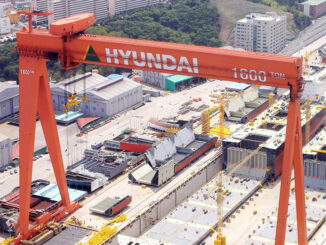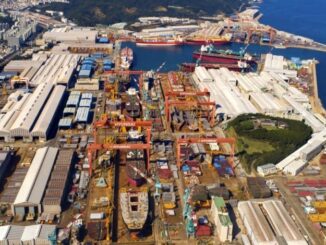
Cost of Port Cranes from South Korea
-
Ship-to-Shore (STS) Container Cranes:
-
Cost: ~$10 million to $15 million per crane. Standard models are around $10 million, while advanced Super-Post Panamax cranes with longer outreach (e.g., >60m) or automation can reach $12-15 million.
-
Example: Global benchmarks (e.g., ZPMC cranes at $8-12 million) suggest South Korean cranes are slightly pricier due to quality and technology but competitive with European models.
-
-
Gantry Cranes:
-
Cost: $500,000 to $5 million. Smaller gantry cranes for lighter loads start at $500,000-$1 million; heavy-duty container-handling cranes range from $2 million to $5 million.
-
Example: Listings for hydraulic container cranes (20ft/40ft) indicate prices around $1 million for basic models.
-
-
Mobile Harbor Cranes:
-
Cost: $1.5 million to $3 million, based on capacity (e.g., 50-200 tons).
-
-
Cost Factors:
-
Outreach and Capacity: Larger outreach or higher lifting capacity increases costs.
-
Automation: Automated cranes add 10-20% to the price.
-
Installation: Adds $100,000-$500,000 per crane for rail setup, welding, etc.
-
Customization: Tailored designs, common with South Korean suppliers, raise costs.
-
-
HD Hyundai (Hyundai Samho Heavy Industries):
-
Role: Major shipbuilder and crane manufacturer, part of HD Hyundai group, focusing on STS and gantry cranes.
-
Market Activity: Actively pitching to the U.S. for a $20 billion crane replacement market, collaborating with Huntington Ingalls. In 2025, HD Hyundai’s vice chairman discussed supply with U.S. officials.
-
Offerings: Super-Post Panamax STS cranes (~$12-15 million) and customized port solutions.
-
-
Hanwha Ocean Co.:
-
Role: Shipbuilder with growing crane production, acquired Philly Shipyard in 2024 to expand U.S. presence.
-
Market Activity: Positioning as a U.S. maritime partner, with technology transfer for crane production. CEO emphasized crane supply in 2025.
-
Offerings: STS cranes (~$10-15 million) and related port equipment.
-
-
Dongnam Crane (DMC):
-
Role: Specialized marine crane manufacturer, focusing on smaller gantry and deck cranes.
-
Offerings: Gantry cranes ($1-3 million), less emphasis on large STS cranes.
-
-
Busan Port Authority (BPA) Support:
-
Role: Not a manufacturer but drives domestic crane production to reduce reliance on Chinese imports (86% of Busan New Port cranes). Supports R&D and orders for Korean firms.
-
Impact: Boosts HD Hyundai and Hanwha through demand and tech development.
-
-
Market Opportunity: South Korean cranes are competitive as the U.S. seeks to replace Chinese cranes due to security concerns, with proposed 100% tariffs on Chinese equipment.
-
Pricing Edge: South Korean cranes are priced between cheaper Chinese models ($8-12 million for STS) and costlier European ones (e.g., Konecranes, ~$12-18 million).
-
Future: BPA’s localization push and U.S. production plans (e.g., Hanwha’s Philly Shipyard) may lower costs by 2030 through scale and innovation.
-
Data Limitation: Exact 2025 prices are contract-specific and not fully public. The $10-15 million range for STS cranes is based on industry trends.
-
Verification: For precise quotes, contact HD Hyundai or Hanwha Ocean directly or check platforms like Alibaba for indicative pricing (though often Chinese-focused).
Jamieson Greer, the US Trade Representative, has been in South Korea this week where shipbuilding talks have taken place as well as pitches made to become an alternate supply of port cranes.
As well as meeting with government officials, Greer sat down with HD Hyundai vice chairman Chung Ki-sun with the pair discussing his shipyard’s ongoing collaboration with US defence shipbuilder Huntington Ingalls Industries. Chung also said one of his company’s subsidiaries, HD Hyundai Samho, was in a position to deliver port cranes to the US.
Around 80% of the cranes used in American ports are made in China and use Chinese software with Donald Trump carrying over a policy set by his predecessor, Joe Biden, to get these replaced in the coming years. Finland’s Konecranes and Japan’s Mitsui have also pitched to help replace Chinese cranes in the US, a mammoth project expected to cost $20bn.
“We deeply appreciate the United States’ commitment to rebuilding its shipbuilding industry,” said Chung. “HD Hyundai stands fully prepared and willing to contribute wherever our capabilities are needed.”
As the US seeks to diminish China’s maritime dominance, it is turning to the likes of South Korea and Japan for shipbuilding expertise.
We give you energy news and help invest in energy projects too, click here to learn more







